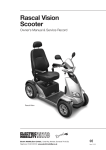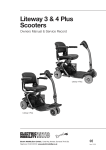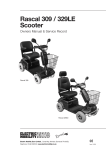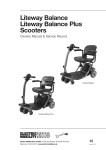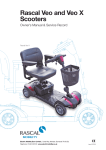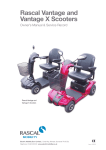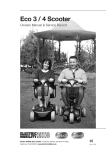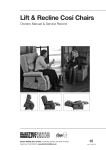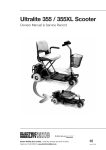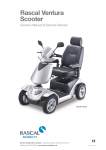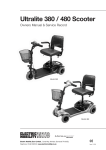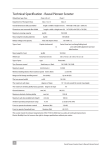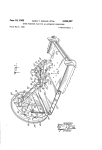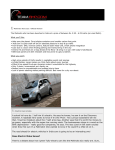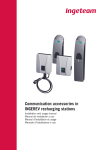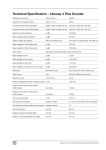Download EME Owners Manual Eco 3 4
Transcript
Rascal Micro Balance Scooter Owners Manual & Service Record Rascal Micro Balance Electric Mobility Euro Limited, Canal Way, Ilminster, Somerset TA19 9DL Telephone: 01460 258100 www.electricmobility.co.uk Issue 1: 03/10 Rascal Micro Balance Electric Mobility Euro Ltd offers the Rascal Micro Balance scooter for convenient indoor and outdoor use. This manoeuvrable scooter provides a comfortable ride for people with disabilities. The Micro Balance is designed for quick and easy stowing in a vehicle and reassembly at your destination. Provided that this scooter is maintained and operated in accordance with this manual it should last for many years. Please read this manual thoroughly before using this scooter. If you have any doubts about warnings or instructions, ask your dealer for an explanation. If at any time you feel you may not be able to control the vehicle safely, do not drive and consult your dealer for a solution. Notice All Electric Mobility Wheelchairs are sold through authorised dealers. Make sure your dealer demonstrates all the features of the product prior to, or when, it is delivered. Warning! This manual contains important safety notices. Please take time to read and understand them. Ignoring them may endanger you or others. 2 2 Rascal Micro Balance Scooter Owner’s Manual & Service Record Contents Dealer information 4 Features and layout 4 Safety information 5 Intended use 5 Safety information 6 Driving 6 Component overview 8 Controls - dashboard 8 Controls - driving controls/accelerator 9 Freewheel device 10 Brakes 10 Armrest width adjustment 10 Seat back folding 11 Armrest angle and Tiller adjustment 11 Transferring in and out of the scooter 12 Operation 12 Driving your vehicle 13 Driving your vehicle - hazards 14 Transporting your scooter 15 Assembling your scooter 16 Battery charging 17 Charging your batteries - further information 18 User maintenance 19 Servicing & maintenance 20 Engineer’s checklist 21 Troubleshooting guide 22 Diagnostic table 22 Frequently asked questions 23 Additional safety information 23 Additional information 24 Technical specification 25 Guarantee & warranty 26 Technical information regarding EMI 26 Brochure request / Warranty card 27 Service log 29 Notes 30 3 Dealer Information This is your contact number for service and support Dealer Stamp Product Model Number Serial Number Date of Purchase Telephone: Email: Owner For product information see serial number plate on the structure under the seat. Manufacturer Electric Mobility Euro Limited Canal Way, Ilminster, Somerset TA19 9DL Company Registration in England No. 2419231 Features and Layout Photo shows the Micro Balance Scooter. See the specification for detailed weights and performance (p25). Handlebars / tiller On/off switch, speed control and paddle controls, forward/reverse Shopping basket Adjustable tiller Footrest Backrest Fold up and width adjustable armrests Battery pack Solid tyres all round Freewheel lever Charging point Magnetic Stabiliser Wheels™ 4 Rascal Micro Balance Scooter Owner’s Manual & Service Record Safety Information Read this manual thoroughly before using or operating the scooter. This handbook is applicable to the Rascal Micro Balance Scooter. If you have any doubt about the content of this manual consult your dealer to resolve the problem. Please read this manual, and ensure your scooter is serviced regularly. Within this manual there are important safety notices. They are clearly marked with the sign (left) Make sure that you understand all these notices. If you have any doubt, contact your dealer. Book symbol: Read the product manual before assembling or operating the scooter. The following symbol appears on the product and in this manual in various locations: Pinchpoint symbol: Wherever you see this sign there is a nearby risk of injury owing to a pinch or crushing point. © 2010 Electric Mobility Euro Ltd. No liability is assumed with respect to the use of any information contained in this publication. While every precaution has been taken in the preparation of this publication Electric Mobility Euro Ltd. assumes no responsibility for errors or omissions nor is any liability assumed for damages resulting from the use of information contained in this publication. This publication, as well as the operational details described herein, is subject to change without notice. Intended use of the scooter This scooter is designed for use by adults with a disability (up to the maximum recommended weight – see the Technical Specification - p25) who require a comfortable scooter which is easily transportable in the average family car. This scooter is intended for use in the home and for shopping areas and trips on paved areas. Kerbs should be avoided, but this scooter can mount kerbs and small obstacles up to 1.57" (40mm). Users could endanger themselves and/or others if they are not capable of driving this scooter safely. Dealers will advise on the most suitable vehicle from the Electric Mobility range, but it is the responsibility of user to ensure that they have the manual dexterity to operate the vehicle, adequate sight and hearing to perceive danger in time, and can at all times operate the scooter safely in the expected conditions. If in doubt we suggest you consult a healthcare professional or your nearest dealer for advice on the most suitable scooter for your particular condition. This scooter has a small front wheel for good manoeuverability so it should not be used on uneven, potholed or rutted surfaces or slippery grassy areas. 5 Safety Information General Warnings Warning ! The operation of scooters can endanger the life of the user and / or third parties. Any user should always be fully capable of operating this vehicle safely. Warning ! Sitting for long periods may increase the chance of thromboses or pressure sores. Users prone to such conditions are advised to take medical advice. Warning ! These scooters have been designed and tested to carry up to the maximum recorded weight in the Technical Specification (p25). This weight must not be exceeded. Warning ! Do not exceed the specification; do not modify this scooter or use it other than as a scooter. Warning ! Additional passengers, even children, should never be carried. Warning ! Electromagnetic interference may affect the performance of this scooter: • Do not operate devices such as CB radios or mobile phones while the scooter is switched on. • Avoid getting close to transmitter masts, such as television and radio stations. • If your scooter ever starts to operate by itself switch it off and report this to your Dealer. Warning ! The operation of any scooter may affect sensitive electronic circuits such as alarm systems, garage door closing mechanisms, or automatic doors in shops. Driving Before driving, refer to ”Driving Your Vehicle” …later in this manual Warning ! Ambient Operating temperature range. Do not use your scooter in temperatures outside the range stated in the specifications section of this manual.(P25) Driving in very hot or very cold conditions can make driving more hazardous. Warning ! Freewheel device/mode. Before getting on the scooter, always check that the freewheel lever is in the "Drive” position. When the lever is in the Freewheel position there is no braking and the scooter could run down a slope and cause injury or even death. NEVER SIT ON THE SCOOTER WHEN IN FREEWHEEL MODE. Warning ! Transferring On and Off. Do not attempt to get on or off your scooter unless it is switched off, at rest, and on a stable, level surface. Never get on or off on a hill. Warning ! Damage. Before driving off check the scooter for damage, particularly that which could affect the controls, wheels and/or drive motor. Warning ! Footrest. Before switching on the scooter, always make sure that your feet are safely on the footrest areas. If you drive forward with your feet still on the ground, they could become trapped under the scooter and serious injury may result. Warning ! Armrests. Do not use the armrests as a support when getting in or out of the scooter. Make sure the armrests are lowered and secure before you start off otherwise you may fall out. Warning ! Entanglement. Do not wear clothing or carry items on the scooter that could become entangled in wheels or other moving parts whilst operating the scooter. Severe injury may result. Warning ! Battery Charge Level. Before driving off, always check the battery indicator. If you are in any doubt, ensure all the batteries are fully charged before starting on a journey. 6 Rascal Micro Balance Scooter Owner’s Manual & Service Record Warning ! Castoring. Be aware that, if you set off when the front wheel is not straight, the initial movement could be partially sideways. Warning ! Power. Unless there is an emergency, do not switch the power off when moving. The Scooter may stop very suddenly. Release the forward / reverse control and the scooter will come to a controlled stop. Warning ! Slopes. On steep slopes the scooter could topple over. Always try to avoid crossing a slope. If you have to cross a slope, take great care to avoid tipping. Never make sharp turns on slopes. Never drive on slippery or icy slopes. - If you are not comfortable with the hill gradient, consider an alternative route. See “Driving Your Vehicle” (see page 14) – Hazards for more advice. Warning ! Kerbs. You should always try to avoid driving up or down kerbs as this may cause the scooter to topple. Use access ramps wherever possible. Never attempt to climb or descend kerbs greater than that noted in the Technical Specification. If you have to climb or descend a low kerb, always tackle it straight on. See “Driving Your Vehicle” – Hazards for more advice. Warning ! Speed. Turning at maximum speed might cause the scooter to topple over. Always slow down for turns. Always slow down when amongst pedestrians and ensure you do not run into them. Warning ! Stopping. If the scooter stops suddenly when turning, it might topple. Try not to brake when turning. Always take particular care when turning. Warning ! Reversing. Always take particular care when reversing the scooter as injury to other people may occur if safe distances are not maintained. Warning ! Leaning Over. Do not lean sideways, as this could cause the scooter to topple. Warning ! Escalators. Never drive the scooter onto an escalator as this could cause the scooter to topple and result in severe injury. Warning ! Roads. This scooter is not designed or approved for use on public roads, apart from crossing roads at designated places. Warning ! Driving in Poor Visibility. Scooters are not easily seen. Your scooter is not intended for use in darkness or in poor visibility. Warning ! Front Basket. The basket mounted on the front has a weight limit of 6.6 lbs or 3.0 kgs. Do not exceed this as it could affect steering. Do not carry or attach anything to the handlebars or controls as this could affect the driving safety. Warning ! Hot Surfaces. If the scooter is left out in the sun, surfaces could become extremely hot. Always try to park the vehicle in the shade. Warning ! Seats in Vehicles. This scooter is not suitable for use as a seat for an occupant when in a motor vehicle. Warning ! Stabiliser Wheels. Your Rascal Micro Balance has two small stabilising wheels; you should avoid using your scooter in situations where the stabilising wheels contact the ground or obstacles when you are not turning. 7 Component Overview 1. 2. 3. 4. 5. 1 Front Section with handlebars Rear Section Seat Battery Pack – incorporates charging point Shopping basket 3 2 4 5 Controls – Dashboard Before driving your vehicle it is important to familiarise yourself with the controls. Do not attempt to drive the vehicle before reading the rest of this Handbook. 1 4 3 6 2 2 5 5 Description of the Controls 1. Battery Condition Indicator: This meter shows the level of charge in the batteries. When in the green section the batteries are fully charged. When in the yellow and red sections, the batteries need recharging and when in the red section the batteries urgently need recharging. Note: When the vehicle is climbing an incline or starting off, the level may drop momentarily; this is normal. 2. Power On/Off key: Switch the power to the scooter on and off by inserting and turning the key provided. Remember to switch off when not in use. Do not leave the power key switched on when not in use. Note that this switch can also be used to “immobilise” the scooter to help prevent it being used, or stolen. 3. Rotary Speed Control: This control enables the user to increase or decrease the pre-set top speed of the scooter. When the control button is rotated in a clockwise direction, the maximum speed the scooter can achieve is increased; when the control button is rotated in a counter-clockwise direction the maximum achievable speed is reduced. Set the maximum speed to low until you are confident in driving the scooter safely. Do not adjust the speed when the vehicle is moving, but reset it when you are stationary. If you become alarmed at your speed release the forward/reverse paddles and the scooter will slow down immediately. 4. Bell: Actuate the bell lever and the bell will sound. 8 Rascal Micro Balance Scooter Owner’s Manual & Service Record 5. Paddle Speed Controller: This is operated by using both hands on the control paddles. The left hand paddle controls reverse speed and the right hand paddle controls forward speed – both to a maximum as pre-set by the rotary speed controller in (3) above. As the paddle is pushed away from the user towards the scooter dashboard, the scooter will steadily increase in speed; either forwards or backwards depending on which paddle is being pushed. NOTE: When reversing the scooter, an audible beeping will be heard. This is quite normal and is designed to warn people of the hazard of a scooter reversing in their immediate vicinity. 6. Power On Indicator / Status LED: This indicator shows the status of the scooter – either on or off. A solid green light indicates that the scooter is on and ready to use and no light means that the scooter is off or totally discharged. Note. The controller has a diagnostic mode: If the LED flashes, this indicates that the controller has detected an error or fault. If this happens refer to the diagnostic table at the back of this manual for a solution. Tip: One of the most common “faults” is that the scooter has been switched on with the free-wheel function enabled– Just turn the power on/off key to the off position, position the freewheel lever in drive and turn the on/off key back to the ON position. Controls – Driving Controls/Accelerator Before driving your vehicle it is important to familiarise yourself with the controls. Warning! Paddle controls. To operate, ensure the scooter is NOT in free-wheel mode and that the power on/off key is switched on. Sit on the scooter and adopt a comfortable position with your feet on the footrests and your hands on the handle-bars - this will help reduce the risk of a jolt causing the paddles to be moved and resulting in an involuntary change in direction or speed. Find an open level area with no obstructions to practice controlling the vehicle until you are confident that you can drive safely. NOTE: To avoid excessive strain on the handlebar assembly, never push the scooter in freewheel mode if a passenger is on-board. Going Forward or Backwards. Push the left paddle away from you and the scooter will move backwards, push the right paddle away from you and the scooter will move forwards. The further you push the paddles, the faster you will go. Releasing the paddles will quickly bring the scooter to a stop. Tip: Never push both paddles together. The paddle direction control can be reversed. Please contact your dealer for support. Turning Left or Right. Apply left or right force to the handlebars. Braking. Whenever the paddles are released, the automatic brake will operate. Practice stopping on level ground to ensure that you know how quickly you can expect your scooter to come to a stop. Paddle Disabling during Start-Up. To prevent sudden unexpected movements the paddles are disabled during start-up. If the paddles are operated when the power key is inserted and turned to the on position, the status indicator LED will give 6 flashes and it will not be possible to drive the scooter. Re-set this safety control by turning the power key to the off position and then turning it back to the on position. Ask your dealer to demonstrate all these functions and make sure you can operate all the modes of the controller before you take your scooter home. 9 Freewheel Device When the scooter is switched off the brakes are automatically engaged. This is called “Failsafe Braking”. Also, if the batteries are flat, the brakes are applied. There may be occasions where you may wish to move the vehicle without power. To do this there is a Freewheel Device fitted on the motor. The Freewheel device allows the vehicle to be pushed without power. To activate, first locate the lever on the right hand side of the scooter seen from behind - see Illustration. • Make sure the power is switched off. • Move the lever into the freewheel position. The vehicle can now be pushed in Freewheel mode. Get your dealer to show you. • Move the lever to engage drive. The vehicle is now braked. This is the normal operating position. IF YOU ARE NOT COMPLETELY SURE OF THIS FEATURE CONTACT YOUR DEALER BEFORE OPERATING THE SCOOTER. NOTE: To avoid excessive strain on the tiller / handlebar assembly, never push or pull the scooter in freewheel mode if a user is on-board. Push the lever UP / FORWARDS to engage freewheel mode. Pull the lever DOWN / BACKWARDS to engage Drive mode. Warning! If the freewheel devices are in “freewheel” mode the braking is disabled. Never select the freewheel mode if the Scooter is on a slope or could be pushed onto a slope. Brakes There are 2 braking systems. The first works with the paddle controls. When the paddles are released the scooter will automatically brake. When the Scooter stops the automatic brake will engage. This will stop the vehicle rolling forward or backward. When you start, the brake will automatically disengage. If the battery becomes very low or exhausted, the brakes automatically engage. Note that even when freewheel is selected, a secondary braking system is applied automatically to limit the maximum speed. You may notice this system when moving the Scooter in freewheel. Armrest Width Adjustment If you require more room in the seat width, loosen the armrest width adjustment using the thumbwheel as shown. Slide the armrests in or out to suit, and tighten up the thumbwheel bolts, making sure that the armrests are equidistant from the centre of the seat and secure. 10 Rascal Micro Balance Scooter Owner’s Manual & Service Record Armrest Angle Adjustment The armrest angle can be adjusted by flipping up the armrest, and loosening the nut near the pivot point. Then turn the armrest adjustment screw clockwise to lower the end of the armrest or anticlockwise to raise it. Once satisfied, tighten the nut and lower the armrest. Warning! Do not use the armrest as a support when getting in and out of your scooter – Armrests are not designed to fully support your weight. Seat Back Folding The Seat Back can be folded forward for transporting only. Never drive the scooter with the seat in the folded forward position. Warning! Always return the seat to the upright position before starting off. If the seat back is tilted forwards in the flat or prone position, the user is very likely to fall and suffer injury, especially if travelling up ramps, kerbs or hills.. Tiller / Handlebar Adjustment The tiller unit can be adjusted to provide the best / most comfortable angle for the user. In order to change this angle, loosen the thumbwheel shown in the image adjacent, move the tiller to the desired angle and then fully re-tighten the thumbwheel. This feature is also used when storing or transporting the scooter. Warning! Never adjust the tiller / handlebar angle so that safe operation cannot be achieved. Always check that the tiller / handlebar angle adjustment thumbwheel is fully tightened before operating the scooter. 11 Transferring In And Out Of The Scooter If you feel at all uncertain about getting in or out of the scooter seek assistance. Transferring into the Scooter from the Front Before getting in: • Make sure that the scooter is on a level surface, and it is not in Freewheel mode. • Make sure the brakes are engaged - try to push the scooter a little to verify that the brakes are working. • Ensure that the power key is turned off. (The green LED / Lamp on the dashboard will not be lit or flashing) 1 • Ensure that the handlebar / tiller adjustment is fully tightened and that any accessories such as the shopping basket are properly fitted • Ensure that the battery strap is fully tightened and that the arrow on the top of the battery unit is facing forwards. • The seat should be facing forwards and be locked. Try to lift the seat to verify it is locked. – If not then tighten the seat post locking thumbwheel. (fig.1) • Adjust the handlebars / tiller so that the front wheel is facing forwards. You are now ready to get in: • Approach the chair from the side and step over the centre part of the scooter with one foot. You should now be straddling the scooter facing forwards and with the seat behind you. With your back to the seat, you can steady yourself using the armrests and then lower yourself gently into the seat. • Lift each of your feet onto the footrest areas. Getting out of the Scooter: • Before getting out of the scooter, be sure that it is on a level surface and the power key is switched to the off position. - If you feel uncertain about getting out, seek assistance. Move the handlebars so that the front wheel is facing directly forwards. • Lift your feet off the footrests and stand up using the armrests to provide you with additional stability if required. (Do not put your full weight on the armrests) Operation Before using the Micro Balance scooter you should make sure that: • The battery is fully charged. (indicating green on the battery indicator) • There is no sign of damage to the scooter. All adjustment thumbwheels are fully tightened. Any accessories such as the shopping basket are properly attached. • That you are capable of controlling the scooter at all times. Kerbs and Obstacles: Try to avoid taking the scooter over obstacles or kerbs. Tackle obstacles head on. Bad Weather: We suggest that it is better to stay at home in bad weather. Remember that you can become wet and cold. Suitable clothes should always be worn. A high visibility jacket should be considered if you are in poor visibility. Remember not to use the scooter in poor light or darkness. 12 Rascal Micro Balance Scooter Owner’s Manual & Service Record Driving Your Vehicle Read this before driving your scooter Warning! Whether or not this is your first mobility vehicle, please read these guidelines as all vehicles differ. Failure to do this may cause damage to you, a third party or the vehicle. Before you set out, do check the weather forecast. We suggest that you make sure you are wearing suitable clothing, whether your journey is long or short. Range. Your scooter has a limited range. Always ensure that your planned journey does not exceed the maximum range in the Technical Specification (page 25) and that your battery is fully charged. If you are taking medication check with your doctor or physician that your ability to control the vehicle will not be impaired and do not drink alcohol and drive. Only use the vehicle for the purpose its intended for. Do not drive through water or on slippery surfaces; do not transport more than one person; do not tow other vehicles or carry excess weight. Check that the freewheel lever is not in the freewheel position / mode. Check the battery charger is disconnected. Check that the battery strap is fully secure. Check that the battery is facing forward. (Arrow on top of battery unit must face forwards) Check that you are properly seated with your feet on the footrests. Check the backrest is upright. Check that the shopping basket is properly affixed to the vehicle and not likely to fall off and cause an accident. Make sure that your shopping basket is not overloaded (See specifications on page 25) Ensure your feet are securely on the footrest areas. Check you have adjusted the seat as instructed in this manual. Make sure the way ahead is clear. Switch on the power. Check the battery level indicator is in the green area. Speed Control. Set the speed control to a low setting. Gently actuate the paddles (either forward or reverse) and steer in the direction required. The vehicle will now move off. The further you push the paddle (either forward or reverse) the faster the vehicle will go. To brake, return the paddles to the neutral position. If you become unsure or feel unsafe release the paddles immediately. As you get accustomed to the power you can increase the speed. Switch Off when Not in Use. To conserve your batteries and prevent the vehicle accidentally moving, always switch off the power when your Scooter is not in use. (On/Off key) 13 Driving Your Vehicle - Hazards Before driving the Scooter you should be aware that, under certain circumstances it could become unstable and tip over. The Scooter has been designed to operate on paved, even surfaces and should not be used on rough, rutted, soft or slippery terrain. Getting on and off the vehicle: Before you get on the scooter make sure that it is on level ground, and not in freewheel mode. Ensure that the armrests are secure. Before you get off, park the scooter on level, stable ground, and switch off. Make sure you get off the vehicle in a safe area. Kerbs and Obstacles: Always try to avoid kerbs and obstacles. Never ride up or down kerbs or obstructions higher than that in the Technical Specification (p25). Always tackle obstacles head on. Use ramps wherever possible and ensure that all wheels will fit on the ramp safely. Never drive or turn across a slope or back down a slope. Note that the anti-tip rollers at the rear of the Scooter may contact the kerb as you descend; this is normal. Hills & Slopes: Going Up Hill: Remember that the seat back should be in the upright position and that you must be properly seated. Make sure you have enough speed to climb the slope. Do not stop or turn the vehicle around. If you have to turn while climbing an incline, keep going until you reach a level area. If you are not comfortable about tackling a gradient, consider an alternative route. Note: Always check that the battery level is high; going up-hill takes a lot of energy. If the level drops too low the vehicle will cut out leaving you stranded. Hills & Slopes: Going Down Hill. Ensure you are properly seated. Turn the speed control dial to low. If you are not comfortable about tackling a gradient, consider an alternative route. Try to avoid crossing slopes – always try to drive straight up and down the slope. NEVER BACK DOWN A SLOPE! Turning: Always Slow down before a turn; turning at speed can cause the scooter to topple. Look in the direction you are travelling – If there is a blind corner, ring the handlebar mounted bell. Turning Circle: So you can judge the turning circle, practice manoeuvring the scooter. This is important to avoid tipping off kerbs and when going into and out of lifts or entrances. Terrain: Do not drive the scooter across soft terrain ( for example, soft dirt, mud, sand, or loose gravel). You could get stuck. Also avoid rutted bumpy ground and keep to well prepared paths. Bad Weather: If it is snowing or icy stay at home! Remember that ice, snow and slippery surfaces such as manhole covers, wet grass and drains could affect braking and steering. Use caution at all times. Immersion: Never enter large puddles or areas of water where the depth and/or current is unknown. Immersion or partial immersion of the scooter may damage it and could leave you stranded. Shower Rooms or Washing: Never take the scooter into a shower or steam room, and never hose it down. It’s sensitive electronics could malfunction if they get wet or damp. Tyres: Your vehicle is fitted with solid tyres that will not puncture. Should they become damaged they should be replaced by your dealer. Do not attempt to replace them yourself. 14 Rascal Micro Balance Scooter Owner’s Manual & Service Record Transporting Your Scooter Warning! Dismantling the scooter involves lifting and handling heavy parts. Warning! Pinching or Crushing. Be careful to avoid being pinched or having your hands crushed when lifting or handling parts. Wear gloves whenever possible. Special attention should be paid when raising and lowering armrests, splitting the front and rear parts of the chassis or rotating/handling the front wheels when dismantling or during re-assembly for transportation in a car or similar. Warning! This scooter is not suitable for use as a seat for an occupant in a motor vehicle. Warning! Do not leave the scooter standing up on its rear rests when not attended – it could topple and injure somebody. Warning! Never stand the scooter up on its rear rests with the battery pack installed. Warning! Do not lift the chassis with the batteries still fitted - injury may result! Your Scooter has been designed to be dismantled and stowed in the average car boot. Contact your dealer for advice on how best to transport your scooter in your vehicle. To transport your Scooter you will need to dismantle it. Follow these instructions. The component weights are recorded in the Technical Specification (p25). Do not attempt to undertake dismantling or lifting without assistance. You are advised to wear gloves. • Turn the power off. (Turn key to the off position and remove from the scooter). • Loosen the seat securing thumbwheel. (fig.1) • Remove the seat by gripping it and pulling up and lifting the seat off the chassis. (fig.2) • Fold the seat arms down & the seat-back forward on itself for easy storage. • Remove the battery pack by undoing the battery securing strap and lifting it clear. Warning, these parts are heavy! (fig.3) • Remove the shopping basket by lifting /sliding up. (fig.4) • Loosen the tiller thumbwheel, fold the tiller unit down and re-tighten the thumbwheel. (fig.5) 1 2 4 3 5 15 • Raise the scooter up and carefully stand it on the rear rests. (fig.6) • Steady the scooter and with the other hand remove the chassis joining pin. (fig.7) • Now carefully allow the front chassis to drop slowly and unhook it from the rear section. (fig.8) • Safely stow the component parts in the boot of the car. (fig.9) • Ensure that all parts are secure so that they cannot move while driving. 7 6 8 9 Assembling your Scooter following Transportation Warning! Assembling the Scooter involves lifting and handling heavy parts. The Scooter has been designed to be easily assembled. Your dealer should advise you on the best way to assemble your Scooter. Warning! Pinching or Crushing. Be careful to avoid being pinched or having your hands crushed when lifting or handling parts. Wear gloves whenever possible. Warning! Never unload your Scooter on sloping, or uneven ground. It could run down the slope and injure someone. Avoid placing it on soft ground as it might get stuck or tip over. After removing your Scooter components from a vehicle and placing them on level ground, assemble as follows: • Stand the rear chassis of the scooter on its rear and hook the front chassis on. (fig.10) • Straighten the chassis halves and insert the joining pin. (fig.11) • Gently lower the scooter back to the horizontal. – Never leave the scooter standing up on its rear supports unattended. • Replace the battery pack making sure that the arrow faces forwards and the battery securing strap is fully done up. (fig.12) • Loosen the tiller thumbwheel, fold the tiller unit up and re-tighten the thumbwheel. (fig.13) • Fit the shopping basket making sure that it locates properly on to the Mounting points. (fig.14) • Replace the seat as follows: • Raise the seat onto the seat post making sure that it locates properly. -test this by trying to turn the seat -If the seat turns it is not correctly located. (fig.15) • Tighten the seat securing thumbwheel. (fig.16) 16 10 11 Rascal Micro Balance Scooter Owner’s Manual & Service Record • Insert the key, switch on and ensure that the battery level indicator is showing green. • Check that the freewheel lever is in the “drive” position /mode and not in the “freewheel”position. • Test the operation of the paddles, speed control and on off switch before using the scooter to go anywhere. The scooter is now ready 12 13 for use. 14 15 16 Battery Charging Warning! When charging batteries NEVER smoke or charge batteries in a place where there are naked flames such as gas-fired heaters as, under exceptional circumstances, batteries may give off gases that could ignite and explode. Always make sure that the battery pack is not damaged. Never charge the scooter battery pack outside as the charger is not designed to get wet. If the charger appears damaged in any way do not use it and contact your dealer for a replacement. Warning! Always charge in a dry, well ventilated area. Warning! It is strongly recommended that the mains socket used for charging the scooter is protected by a 30 m/A RCD (residual current device). Many buildings have sockets protected by a system based RCD. If you are in doubt as to the level of protection in your charging location then either purchase a plug in RCD or consult a qualified electrician to verify that your charging location mains sockets are protected. Warning! If batteries are damaged or frozen they could heat up during charging and in an extreme case, explode. Warning! Do not attempt to open the battery bag/enclosure, there are no user serviceable parts inside. Warning! Never use a different battery charger to that supplied by your dealer. Damage or injury may occur if you do! Warning! When charging batteries NEVER connect or disconnect the charger from the battery pack while it is still connected to the mains. – Remove the charger mains plug from the wall socket having first switched the mains socket off if a switch is provided. Warning! Do not drop your battery pack as damage may occur. Battery packs are heavy - be careful when lifting them. 17 1 2 3 Remove the battery pack from the scooter by undoing the retaining strap and place in a dry, well ventilated place. The charging socket is located on the lower front edge of the battery unit underneath a protective fabric cover (fig.1). Open the protective cover and with the charger (fig.2) disconnected from the mains, push the charger plug into the socket on the battery pack. Plug the charger into the mains wall outlet and switch the outlet on if a switch is provided. When the battery pack is fully charged remove the mains plug from the wall socket and the charging plug from the battery pack. Reposition the cover over the charging socket to keep the dirt and moisture out. Do not leave your battery pack connected to the charger with the mains switched off as this will gradually discharge your battery pack. The battery charger has an indicating lamp that changes colour depending on the charge state of the battery pack. When the charger is connected and switched on the lamp will illuminate amber. When the battery pack is fully charged, the charger lamp will illuminate green. If the lamp illuminates red, this means that the mains power is on but the batteries are not charging. • Red - Power on - not charging • Amber - Charging • Green - Fully charged • No illumination - mains not connected to charger. Warning! Never disconnect a battery while the charger is connected to the mains - Never charge your Battery pack outside or where the charger may get wet. Tip: The battery pack must be removed from the scooter for charging. Charging your Batteries Further information When you receive your vehicle the battery pack is only partially charged – always fully charge it before use preferably over-night. You will need to remove your battery pack from the scooter, be very careful not to drop the battery bag/unit as permanent damage may occur. The batteries are the lifeblood of your vehicle. Their characteristics can change depending on charging, temperature, usage and other factors. Listed below are guidelines to prolong battery life. • After using the scooter, always charge it at the end of the day - even after a short journey. • If you do not use the vehicle for a prolonged period, place the battery pack on charge once a week, overnight. • Always use the correct charger with the correct battery pack. The Micro Balance can only be used with the charger model : HP1202-B, HP1203 or equivalent charger approved by Electric Mobility. • If the battery pack has been flat for a long time (about 2 months) it is recommended you contact your dealer before charging, see warning below. • Do not charge the battery pack in the open – it may rain and the battery charger is not waterproof / suitable for outdoor conditions. 18 Rascal Micro Balance Scooter Owner’s Manual & Service Record • Keep the battery pack in a well-ventilated area and away from any naked flame. • Do not part-charge the battery pack. Allow the charger to complete its cycle. Notice Return your unserviceable battery pack to your supplier or ensure it is disposed of in accordance with the environmental regulations applicable at the time. Warning! If batteries are damaged or frozen they could heat up when charging and, in an extreme case, explode. Batteries are expensive to replace – it is wise to look after them. Batteries are heavy – make sure you always lift them correctly and be very careful not to drop them! User Maintenance It is important for safety that you carry out the following checks before use. • • • • • • • • Visually check the machine for damage. Visually check the tyres for damage. Check that the seat and tiller are secure. Ensure that all thumbwheels are tight Check the armrests are secure. The battery pack is fully charged. Check the operation of the brakes and if you have any concerns, contact your dealer. Keep your vehicle clean by using a damp cloth and soapy water – never use a hose, pressure washer or strong detergents /solvents. Important - Possible faults As you get used to the scooter you will get a feel for how it behaves. If something feels unusual, for instance the vehicle does not accelerate or brake smoothly, the vehicle tries to turn to one side, the brakes are not holding on a slope or the controller operates strangely, stop using the scooter, contact your dealer immediately and explain to the engineer exactly what the problem is. Disposal Contact your dealer for advice before you consider disposing of your scooter. They will be aware of the environmental regulations in force at the time and will assist you to meet the applicable environmental legislation. 19 Servicing and Maintenance This vehicle is designed for minimum maintenance. However it is recommended that a competent engineer service the vehicle at least once a year. If the vehicle is used constantly we recommend a twice yearly maintenance. Ensure the engineer stamps the Service Log on completion for all servicing carried out on this vehicle. Keep all receipts for servicing and repairs with this handbook. This may add value when selling the vehicle. When the vehicle is due for it’s service make sure you report any concerns you have, preferably when you book the service (see points to look out for below). On completion of the service, always test the vehicle before the engineer leaves and make sure you are satisfied with the work carried out. Points to look out for: • Are there any strange noises from the wheels or does the frame creak ? • Is the battery charging up correctly – is the “full” charge green light on after charging ? • When turning, does the Scooter respond equally to left and right turns ? • Does the Scooter stop smoothly when paddles are released ? • Does the Scooter tend to pull to one side ? • Does the speed control work ? • Does removal of the key disconnect all power to the scooter ? • Has anything come loose ? • Does the vehicle perform as well as it did when it was new ? • Are there noises or rattles that were not there before ? • Are there any signs of damage, corrosion or cracking ? • Is the battery bag/unit undamaged ? 20 Rascal Micro Balance Scooter Owner’s Manual & Service Record Engineer’s Checklist for Scooters Obtain all comments from the customer on the condition and serviceability of the Scooter and then complete an Initial diagnostic road test. Record all defects to be corrected. Now check, test and complete the following: • Wheel bearings for wear and lubricate • The On/Off key switch for correct functioning • The speed indicator for correct indications • Wear or damage to tyres or wheels • Bodywork fixtures for damage, corrosion or cracking – ensure that all warning labels are in place and visible. • Operation of securing knobs. Do they secure the armrests & tiller? Do they need replacing? • Motor performance, excessive noise, leaks or damage. • Motor speed check • Electromagnetic brake operation • Freewheel operation . • Frame for damage or cracks • General check for corrosion, repair or protect as necessary • All operational controls work correctly • Operation of armrest attachment. Thumbwheel locks? Do they tighten to secure the armrests? Replace as necessary. • Tighten all nuts & bolts • Paddle play, correct operation and response and carry out any necessary adjustment or replacement • Correct all defects found and determine if the vehicle is roadworthy. • Battery contacts & signs of corrosion. • Final road test • Check all cables for damage, abrasion, corrosion and that screening is intact. Replace as necessary. Ensure that the tiller cable grommet and securing straps are present and fully functional. • Clean vehicle • Battery condition and charger operation • Customer road test • Seat mounting and catch for wear or damage 21 Troubleshooting Guide This table is a guide to fault finding. The fault may be a simple fix. If you have any doubts phone your dealer. Symptom Solution • Scooter does not move. when power is switched on. • • • • • Vehicle pulls to one side. • Check for tyre damage. • Possible Motor failure - contact dealer. • Binding Bearings – contact dealer • Vehicle behaves erratically when driven. judders or cuts out ? • Possible electronic problems - contact dealer. • Short Range • Check tyres for damage. • Check batteries are fully charging. • Check vehicle moves normally in Freewheel Batteries flat - check level. Is the charger connected? Is Freewheel engaged (ON)? Safety cut-out has operated due to overload? Press the white reset button on the rear left wing of the scooter. If the cut-out operates again, contact your service agent for assistance. • Freewheel has been selected while power is on Ensure freewheel is not selected; switch off and on NB the power indicator may flash indicating that freewheel has been selected. Diagnostic Table Your scooter controller provides diagnostic information by lamp / LED indications on the dashboard. The lamp will give a different number of flashes depending on the fault – see below: No. of flashes 1 2 3 4 5 Description Battery needs charging Battery voltage too low Battery voltage too high Current limit time out Brake fault / in freewheel No. of flashes 6 7 8 9 Description Paddle depressed at start Speed pot error Motor volts error Other internal error Your dealer is there to help you but they can only do this if you give them as much information as possible. Remember correct information will get the problem fixed quicker and save you money. Phone the dealer and explain exactly what the problem is, recounting as much detail as possible including the indicated faults. 22 Rascal Micro Balance Scooter Owner’s Manual & Service Record Frequently Asked Questions I want to transport my scooter in a car. There are various techniques. The Micro Balance is designed to break down into very manageable units. Make sure your dealer has demonstrated the easiest way of loading your scooter into your car. See transporting your scooter. Can I fit weatherproofing such as a canopy ? No, the Micro Balance Scooters are too small to have canopies as they can adversely affect stability and handling. How long will my battery last ? This is a difficult question as it depends on many factors. The life of a battery depends upon the number of cycles the battery goes through, the peak loads and on the conditions of use. Some general advice about battery care: • Keep it charged, and do not let the battery run completely flat. • Ensure your battery pack is fully charged at the end of the charging cycle • Batteries may not perform as well in very cold weather. • Change your battery if you find it is not performing as well as new. Care can prolong the life of the batteries but remember that, in time, all batteries will fail to perform to specification. What range can I expect ? The generally expected range shown in the Technical Specification (p25). However, range can be affected by many things such as: • Temperature. Cold weather can reduce the output of the batteries. • Type of terrain. Obviously climbing hills takes more energy than driving on the flat. • Weight of the person. • The condition and charge of the batteries. • Faulty or old batteries or a faulty charger Important Rule: Always use the correct charger with the correct batteries and ensure the battery is charged before you start out. How long should I keep my scooter before I change it ? It is important that the vehicle you have suits your needs and abilities. Your Rascal Scooter should serve you well for many years but change it if at any time you feel it no longer meets your needs. Consult your dealer on the condition of your vehicle and remember vehicles of any type become more expensive to maintain the older they get. Additional Safety Information Carrying Weight on the Scooter Bags or Luggage: Never carry bags, except those specified as accessories or in the shopping basket; failure to note this warning could result in tipping over backwards causing injury or death. Only carry small bags on your lap and ensure they cannot affect the control of your vehicle. Seat Arms: Do not carry or attach anything to the seat arms. Anything attached to the seat arms could affect stability, or interfere with the control of the vehicle. Other Precautions Paddles: Do not touch the paddles when the getting in or out of the Scooter; always make sure the Scooter is switched off. Modifications: Unauthorised modifications could result in injury or permanent damage. Such modifications will invalidate any guarantees. Other Items: Only fit approved products or accessories. 23 Child Safety This product is designed to be operated by adults. Children should not be allowed to tamper with the controls or play on the vehicle. Do not carry children as passengers. The scooter is designed for a single passenger only. Keep all packaging well away from children. They could be harmed. Additional Information Owners Manual: Replacement copies are available from: Electric Mobility Euro Ltd. Canal Way, Ilminster, Somerset, TA19 9DL Telephone: 01460 258100. If you are visually impaired, please contact the Company to discuss your requirements. However, you should not use a scooter in a public place if you cannot see well enough to ensure your own, and others safety. For Information regarding other Electric Mobility products contact your dealer or log on to the Electric Mobility Website www.electricmobility.co.uk 24 Rascal Micro Balance Scooter Owner’s Manual & Service Record Technical Specification - Rascal Micro Balance Scooter type Class Class A, B or C Class B Department of Transport Class Class 1 2 or 3 Class 2 Overall dimensions fully assembled length x width x height mm (in) 980 (38.6) x 520 (20.5) x 880 (34.6) Dimensions seat folded & tiller folded length x width x height mm (in) 980 (38.6) x 520 (20.5) x 740 (29.1) Maximum carrying capacity kg (lb) 113 (250) Mass (weight) including batteries kg (lb) 39.7 (87.5) Mass (weight) of heaviest part (rear chassis) kg (lb) 14 (30.9) Mass (weight) of front chassis kg (lb) 9.7 (21.4) Mass (weight) of shopping basket kg (lb) 0.4 (0.9) Mass (weight) of battery pack kg (lb) 9.0 (19.8) Maximum shopping basket load kg (lb) 3.0 (6.6) Battery voltage and capacity volts and ampere hours 12V 12Ah x 2 including tiller control Type of seat Standard seat with folding backrest and adjustable arms Mass (weight) of seat kg (lb) 6.6 (14.6) Wheel size front/rear mm (in) Single 152.4 (6) / Rear 203.2 (8) Type of tyres type Foam filled solid Maximum speed km/h (m.p.h.) 6.4 (4.0) Minimum braking distance from maximum speed m (ft) 1.3 (4.26) Range on full charge and flat ground km (miles) Up to 10 (6.2) The turn-around width m (ft) 1.32 (4.3) The maximum safe slope degrees of slope 6˚ - Do not exceed. -The scooter may topple! The maximum climbing ability facing upwards degrees of slope 6˚ Ground clearance mm (in) 40 (1.57) Maximum obstacle climbing ability mm (in) 40 (1.57) Maximum safe descendable kerb height mm (in) 40 (1.57) Ambient operating temperature range ˚C ( ˚F ) 2(35.6) to 40(104) Due to a policy of continual improvement, Electric Mobility reserves the right to change specifications without prior notice. 25 Guarantee and Warranty Lifetime Frame Guarantee Electric Mobility Euro Ltd guarantees the frame of its vehicles to be free from defect in materials and workmanship under normal use as described in this document for the lifetime of the vehicle. Should a defect in materials or workmanship appear, Electric Mobility Euro Ltd, will repair, or at its option, replace the frame to the original owner. One Year Limited Warranty Electric Mobility Euro Ltd warrants its products against defects in material and workmanship for a period of one year, providing the products are properly assembled, operated and maintained in accordance with the vehicle Owners Manual. This limited warranty is limited to the original purchaser. This limited warranty commences on the date of the original retail purchase or original use, whichever occurs first, providing the warranty card is fully and correctly filled out and returned to Electric Mobility Euro Ltd Customer Service Department within 15 days from receipt of product. If a defective part appears within the stated limited warranty period and the purchaser has given Electric Mobility Euro Limited immediate notice the Company will repair the part or at its option replace the part with a similar part. No allowance will be made for repairs to any equipment without the expressed written or verbal approval of Electric Mobility Euro Limited. Any description, specifications, samples, models, bulletins or similar materials used in connection with the sales of Electric Mobility Euro Limited products are for the sole purpose of identifying the equipment and are not to be construed as expressed warranties. This limited warranty applies only to the original purchaser of the equipment and is not transferable. Electric Mobility Euro Ltd shall not be liable for special, indirect or consequential damage. Electric Mobility Euro Ltd’s liability on any claim of any kind including negligence for any loss or damage arising out of, connected to, or resulting from the order of the performance thereof the design, manufacture, sale, delivery, resale, direction and instructions, inspection, repair or use of any equipment covered by or furnished by, under this order, shall in no case exceed the price paid by the purchaser for the equipment. This limited warranty does not cover normal maintenance service, or periodic adjustments necessitated by use of wear. Under no circumstances will charges for labour, consequential damage or repair expense be allowed after 30 days from receipt of product. Technical Information Regarding EMI Important Technical Information regarding Electromagnetic Interference (EMI) The intensity of interference from electromagnetic energy is measured in volts per meter (v/m), which refers to the strength of the electrical source (voltage) as it relates to the distance away from the object being considered (in meters). Resistance of a scooter/wheelchair to certain EMI intensity is commonly called its “immunity level”. 20 volts/meter is a generally achievable and useful immunity level against interference from radio wave sources (the higher the immunity level, the greater protection). Your scooter has been tested and found to meet the required immunity level from Electromagnetic Interference (20v/m): the recommended density of interference from electromagnetic energy. Warning! Even with the immunity level of 20 volts/meter, certain precautions must be followed to ensure your scooter/wheelchair will not be affected by outside electromagnetic sources. • Do not operate devices such as CB radios or mobile phones while the vehicle is switched on. • Avoid getting close to transmitter masts, such as television and radio masts. • Note you may experience interference when close to ambulance or fire stations. If your vehicle starts to operate by itself switch it off and report this to your Dealer. 26 Rascal Micro Balance Scooter Owner’s Manual & Service Record Brochure Request Do you have a friend or colleague that would be interested in an Electric Mobility product? If so cut out this coupon and send it to the address shown on the back of the manual. My Dealer’s Company name is: Please can I have a free no-obligation home demonstration. Please send me a brochure of the range of products. My friend’s name is: My friend’s address is: County: Postcode: My friend’s telephone number is: If you are visually impaired, please contact the Company to discuss your requirements. However, you should not drive a vehicle in a public place if you cannot see well enough to ensure your own, and others safety. Postage will be paid by: Electric Mobility Euro Ltd., FREEPOST (SWBI 1045), Ilminster, Somerset, TA19 9ZA Dealer Information - Warranty Card This section is to be filled out by the Dealer and sent to Electric Mobility Euro Ltd. Dealer: Product Description: Serial No.: Invoice No.: Customer Name & Address: County: Postcode: Telephone No.: Email address: Did you buy on the Internet? or through a local dealer? Please tick the relevant box. Date received at Dealers: # Postage will be paid by: Electric Mobility Euro Ltd., FREEPOST (SWBI 1045), Ilminster, Somerset, TA19 9ZA 27 # Electric Mobility Euro Ltd., FREEPOST (SWBI 1045), Ilminster, Somerset, TA19 9ZA Electric Mobility Euro Ltd., FREEPOST (SWBI 1045), Ilminster, Somerset, TA19 9ZA Service Log Notice for the Service Engineer. Please make sure this part is stamped and dated after each service. Dealer stamp - 1st Service Dealer stamp - 2nd Service Dealer stamp - 3rd Service Dealer stamp - 4th Service Dealer stamp - 5th Service Dealer stamp - 6th Service Dealer stamp - 7th Service Dealer stamp - 8th Service 29 Notes 30 Rascal Micro Balance Scooter Owner’s Manual & Service Record Notes 31 Rascal Micro Balance Scooter Manufactured by Electric Mobility Euro Limited, Canal Way, Ilminster, Somerset TA19 9DL Telephone: 01460 258100 www.electricmobility.co.uk E. and O.E. Issue 1: 03/10
































